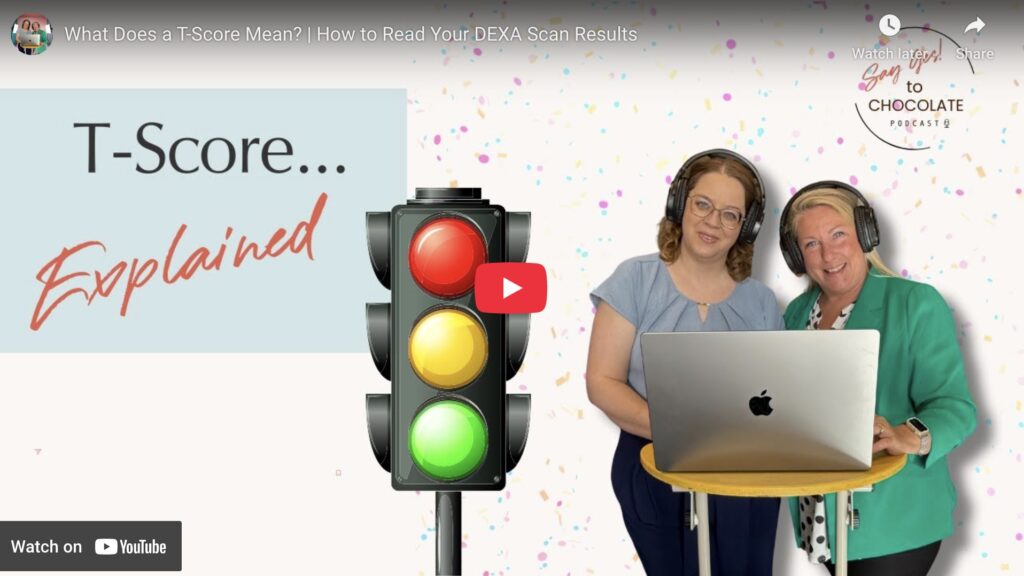What Does Your T-Score Mean? How to Understand Your Bone Density Results
Most women don’t think about their bones until something goes wrong—or until a doctor hands them a DEXA scan with numbers like -1.0 or -2.5 that look more like a math problem than a health result.
But here’s the truth: your T-score is one of the most important numbers you can know in midlife, because it reflects your bone density and risk for osteoporosis. And the good news? Once you understand it, you can take simple steps to support your bones and protect your future strength.
In this episode, we’ll cover:
- What a T-score is and why it matters
- How to interpret your results using the “traffic light” system
- Practical steps you can take if your numbers are concerning
- Why your T-score is only part of the bone health picture
🎧 Listen to the full episode:
🎥 Watch the full episode:
Why Your T-Score Matters in Midlife
Bone health often feels invisible—until it isn’t. For women in their 40s, 50s, and beyond, bone loss can accelerate quickly, especially after menopause when estrogen levels drop.
A T-score gives you a snapshot of your bone mineral density (BMD) compared to a healthy 30-year-old (the age when most people hit peak bone mass). Think of it as a “report card” for your bones:
- ✅ -1.0 and above (Green Zone): Normal bone density
- ⚠️ -1.0 to -2.5 (Yellow Zone): Osteopenia, or early bone loss
- 🚨 -2.5 or lower (Red Zone): Osteoporosis, with higher fracture risk
The challenge? These numbers often feel scary, confusing, and overwhelming. That’s why breaking them down in plain English is so empowering.
Decoding the Numbers: T-Score, Z-Score, and BMD Explained
Here’s a simple way to think about it:
- T-score: Compares your bones to a healthy 30-year-old. Used for diagnosis.
- Z-score: Compares your bones to others in your same age group. Informational only.
- BMD (Bone Mineral Density): The raw data that gets converted into your T- or Z-score.
💡 A quick tip: Don’t panic if you see a negative number. A T-score of -0.7 still falls in the normal range. The negative sign doesn’t mean your bones are crumbling—it just means you’re slightly below that 30-year-old baseline, which is part of normal aging.
How to Take Action: Small Shifts That Protect Your Bones
If your T-score falls in the yellow or red zones, it’s a call to action—but not a reason to give up hope. Here are simple, science-backed shifts that make a big difference over time:
- Prioritize protein. Aim for 20–30g of protein at each meal to support bone-building. (We love Equip Protein Powder as a simple add-in.)
- Move with intention. Weight-bearing and resistance exercises are powerful for stimulating bone growth. Even 10–15 minutes a day matters. Or check out the 1x/week osteogenic loading program at OsteoStrong!
- Check your nutrients. Calcium, vitamin D3, vitamin K2, and magnesium are critical for bone strength. Supplements can help fill the gaps.
- Ask about medications. Common drugs like acid reflux meds (PPIs), corticosteroids, and some antidepressants can negatively affect bone density. Knowledge is power when talking to your provider.
✨ Remember: even if you’re starting in the yellow or red zone, your bones can respond to lifestyle shifts. It’s never too late.
Encouragement: Your T-Score Isn’t the Whole Story
Here’s the big picture: a T-score measures bone density, but it doesn’t tell you everything about bone quality. Blood tests and advanced scans like REMS can give a fuller view of your fracture resistance.
So if your numbers aren’t where you want them, don’t panic. Instead, think of your T-score as a starting point for making changes that support your bones, energy, and confidence.
You don’t need perfection. You just need one step forward.
🎧 Want the deeper dive? Listen to the full Say Yes! to Chocolate podcast episode HERE!
✨ Ready to simplify your wellness? Download the free KISS Start Guide — it’s your step-by-step reset for midlife energy and health.
Closing Thought
Understanding your T-score doesn’t have to feel overwhelming. With the right perspective (and a little chocolate along the way), you can take small, simple steps that strengthen your bones and protect your future.
💛 Remember: better > perfect. One simple shift this week can make all the difference.

+ show Comments
- Hide Comments
add a comment